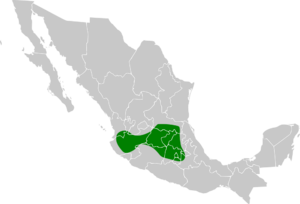Aztec rail facts for kids
Quick facts for kids Aztec rail |
|
|---|---|
 |
|
| Conservation status | |
| Scientific classification | |
| Genus: |
Rallus
|
| Species: |
tenuirostris
|
 |
|
The Aztec rail or Mexican rail (Rallus tenuirostris) is a special type of bird that lives only in Mexico. It's part of the Rallidae family, which includes rails, gallinules, and coots. This bird is currently considered a Near Threatened species. This means it needs protection because its numbers are decreasing.
Contents
About the Aztec Rail's Family
Scientists used to think the Aztec rail was the same as other rails. These included the mangrove rail and the king rail. However, a study in 2013 showed they are all different species. This was based on their genes and how they look. Most scientists now agree that the Aztec rail is its own unique species. It is also considered "monotypic." This means it is the only species in its specific group.
What Does the Aztec Rail Look Like?
The Aztec rail is about 33 to 42 centimeters (13 to 17 inches) long. Males weigh between 271 and 331 grams (9.6 to 11.7 ounces). Females are a bit lighter, weighing 220 to 268 grams (7.8 to 9.5 ounces). Both male and female birds look very similar.
This bird can have two different looks, called "morphs."
- Dark morph: This bird has rich brown feathers on its back. It also has blackish marks there. Its cheeks are a pale pinkish color, and its chin and throat are white. Its belly feathers are reddish-brown. The sides have dull brown and white stripes.
- Light morph: This bird has a pale white center on its belly. It also has a pinkish-cinnamon color mixed in.
Young Aztec rails look a bit duller and darker than the adults. Their underparts are also paler.
Where Does the Aztec Rail Live?
The Aztec rail lives mostly in central Mexico. This area includes states like Nayarit, San Luis Potosí, Veracruz, and Guerrero. Recently, many birds have also been seen in Chihuahua. They were mostly found in the valley of the San Pedro River.
This bird likes to live in highland freshwater marshes. These can be marshes that are wet all year or only during certain seasons. They live at high elevations, from about 800 meters (2,600 feet) up to at least 2,500 meters (8,200 feet).
How Does the Aztec Rail Behave?
Moving Around
The Aztec rail usually stays in the same area all year. However, some birds might move from permanent wetlands to temporary ones. This often happens during the rainy season, which is from May to September.
What Does It Eat?
The Aztec rail mainly eats crustaceans, especially crayfish. Its diet also includes other things like snails and slugs (molluscs). It eats insects that live on land and in water. Sometimes, it might also eat spiders, fish, and small amphibians.
How Does It Raise Its Young?
The main time for Aztec rails to breed is from May to August. Sometimes, they might also breed in April and September. One nest that was studied was shaped like a dome. It was made from spikerush plants. This nest was built within a patch of spikerush. A female Aztec rail usually lays about five eggs.
What Sounds Does It Make?
The Aztec rail has different calls. During courtship, when they are looking for a mate, they make loud, harsh "kik" or "kuk" sounds. Both male and female birds make a series of "chac" notes. This is like an "advertising call" to show where they are. They also make a soft, fast "tuk" sound.
Protecting the Aztec Rail
The IUCN (International Union for Conservation of Nature) has listed the Aztec rail as "Near Threatened." This means it is close to becoming endangered. The bird lives in a moderately sized area, and this area might even be growing. However, there are only about 15,000 adult birds left. This number is believed to be going down. The freshwater marsh homes of the Aztec rail are in danger. This is because of more farming, factories, and city growth.


